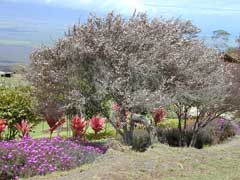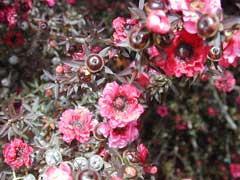 |
|
http://www.hear.org/starr/ |
 |
| http://www.hear.org/starr/ |
Translate this page:
Summary
Bloom Color: Pink, Red. Main Bloom Time: Early spring, Late spring, Mid spring. Form: Irregular or sprawling, Rounded.
Physical Characteristics

 Leptospermum scoparium is an evergreen Shrub growing to 5 m (16ft) by 3 m (9ft) at a medium rate.
Leptospermum scoparium is an evergreen Shrub growing to 5 m (16ft) by 3 m (9ft) at a medium rate.
See above for USDA hardiness. It is hardy to UK zone 8 and is frost tender. It is in leaf all year, in flower from May to June. The species is hermaphrodite (has both male and female organs) and is pollinated by Insects.
Suitable for: light (sandy), medium (loamy) and heavy (clay) soils and prefers well-drained soil. Suitable pH: mildly acid and neutral soils. It cannot grow in the shade. It prefers dry or moist soil. The plant can tolerates strong winds but not maritime exposure.
UK Hardiness Map
US Hardiness Map
Synonyms
Plant Habitats
Woodland Garden Sunny Edge; Hedge;
Edible Uses
Edible Parts: Manna
Edible Uses: Tea
The fresh, pungent leaves are a fragrant and refreshing tea substitute[144, 153, 183]. Of excellent quality, in taste trials this species has often received higher marks than the traditional China tea obtained from Camellia sinensis[K]. It is important to brew the leaves for considerably longer than normal teas to ensure the flavour is released into the water[K]. A sweet manna is sometimes exuded from the stems as a result of insect damage[153, 173]. Another report says that manna is reported to form on the leaves[183].
References More on Edible Uses
Medicinal Uses
Plants For A Future can not take any responsibility for any adverse effects from the use of plants. Always seek advice from a professional before using a plant medicinally.
None known
References More on Medicinal Uses
The Bookshop: Edible Plant Books
Our Latest books on Perennial Plants For Food Forests and Permaculture Gardens in paperback or digital formats.

Edible Tropical Plants
Food Forest Plants for Hotter Conditions: 250+ Plants For Tropical Food Forests & Permaculture Gardens.
More

Edible Temperate Plants
Plants for Your Food Forest: 500 Plants for Temperate Food Forests & Permaculture Gardens.
More

More Books
PFAF have eight books available in paperback and digital formats. Browse the shop for more information.
Shop Now
Other Uses
Dye Hedge Hedge Insecticide Roofing Wood
This species can be grown as a hedge in the milder areas of Britain[200] and is reasonably tolerant of maritime exposure. Plants should not be trimmed back into old wood, however, because they do not regenerate from such treatment. A yellow-green dye is obtained from the flowers, branches and leaves[168]. A greenish-black dye is obtained from the flowers[168]. Source of an insecticide[153] (no further details). Wood - red, strong, elastic. Used for inlay work, cabinet making etc[61]. The bark is used for roofing huts[61].
Special Uses
Hedge Hedge Scented Plants
References More on Other Uses
Cultivation details
Landscape Uses:Border, Screen, Seashore. Succeed in almost any neutral or acid soil of good or reasonable quality[200], preferring a light sandy loam and full sun[200]. Succeeds in dry soils. Prefers a position sheltered from hot or cold drying winds. We have found the plants to be fairly tolerant of maritime exposure[K]. The plant only succeeds outdoors in the milder areas of Britain. Hardy to about -10°c, succeeding outdoors in most of Southern Britain[184]. A polymorphic species, many forms have been developed for their ornamental value[182]. There are some dwarf varieties that grow very well in pots in cold greenhouses and conservatories[260]. Resents root disturbance. Plants do not regenerate from old wood[200]. The bruised leaves and the flowers are pleasantly aromatic[219, 245]. Plants in this genus are notably resistant to honey fungus[200]. Special Features:
Not North American native, Attractive flowers or blooms.
References Carbon Farming Information and Carbon Sequestration Information
Temperature Converter
Type a value in the Celsius field to convert the value to Fahrenheit:
Fahrenheit:
The PFAF Bookshop
Plants For A Future have a number of books available in paperback and digital form. Book titles include Edible Plants, Edible Perennials, Edible Trees,Edible Shrubs, Woodland Gardening, and Temperate Food Forest Plants. Our new book is Food Forest Plants For Hotter Conditions (Tropical and Sub-Tropical).
Shop Now
Plant Propagation
Seed - sow spring in a greenhouse and only just cover the seed. Prick out the seedlings into individual pots when they are large enough to handle and grow them on in the greenhouse for at least their first winter. Plant out in late spring or early summer, after the last expected frosts, and give some protection from the cold for their first winter or two outdoors. The seed remains viable for many years. Cuttings of half-ripe wood, 5 - 8 cm with a heel, early August in a frame. Over-winter in the greenhouse for its first year. Good percentage[78]. Cuttings of almost mature wood, 4 - 5 cm with a heel, October/November in a frame. Good percentage[78].
Other Names
If available other names are mentioned here
Native Range
AUSTRALASIA: Australia (Tasmania, New South Wales (southeast), Victoria (west)), New Zealand (Chatham Islands Territory, North Island, South Island, Stewart Island)
Weed Potential
Right plant wrong place. We are currently updating this section.
Please note that a plant may be invasive in one area but may not in your area so it's worth checking.
Conservation Status
IUCN Red List of Threatened Plants Status :

Growth: S = slow M = medium F = fast. Soil: L = light (sandy) M = medium H = heavy (clay). pH: A = acid N = neutral B = basic (alkaline). Shade: F = full shade S = semi-shade N = no shade. Moisture: D = dry M = Moist We = wet Wa = water.
Now available:
Food Forest Plants for Mediterranean Conditions
350+ Perennial Plants For Mediterranean and Drier Food Forests and Permaculture Gardens.
[Paperback and eBook]
This is the third in Plants For A Future's series of plant guides for food forests tailored to
specific climate zones. Following volumes on temperate and tropical ecosystems, this book focuses
on species suited to Mediterranean conditions—regions with hot, dry summers and cool, wet winters,
often facing the added challenge of climate change.
Read More
Expert comment
Author
J.R.Forst.&G.Forst.
Botanical References
1144200
Links / References
For a list of references used on this page please go here
Readers comment